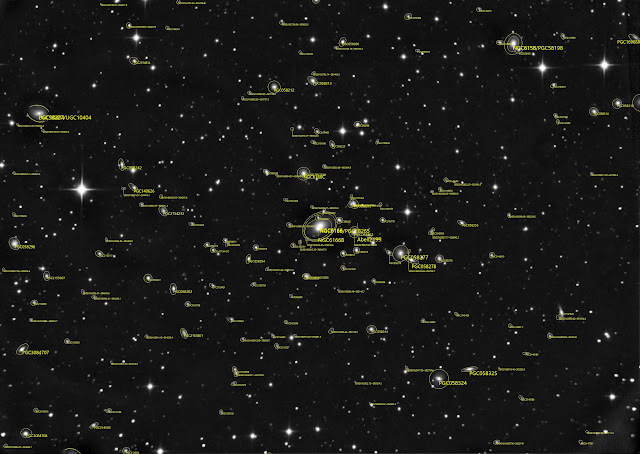Just notes, nothing fancy....
Monday, May 5, 2025
Unprocessed Mars until May of 2025!
Saturday, May 3, 2025
Whale Galaxy in LRGB
I couldn't be more thrilled with how this turned out! As a novice, every image I capture feels like a milestone, and this one is no exception. With just 80 minutes of integration and only a couple of 5-minute subs for color, the galaxy already reveals stunning details. The structure and glow make it a target I know I'll revisit in the future. It's incredible to think that light from this distant world traveled across the cosmos for millions of years, only to end up in my telescope. Moments like these remind me why I love astrophotography—it's a chance to connect with the universe in a way I never imagined possible.
...and HD sized crop!
Galaxies Galore with Abell 2199
Checking for target while imaging, as I nearly always do, I spied a tiny galaxy in a pretty dark portion of the sky, NGC6166.
Solved with annotations
While processing this portion of our universe I spied galaxies: NGC6166, UGC10404, PGC058277, NGC6158 and SDSS J162915.46+392226.4. The latter of which is listed as a galaxy with these measured values
Radial velocity / Redshift / cz : V(km/s) 83829 [54] / z(spectroscopic) 0.33279 [0.00018] / cz 99768.0 [54.0]
And RA/DEC of
16 29 15.462 +39 22 26.41
Per
https://simbad.cds.unistra.fr/simbad/sim-id?Ident=%406143502&Name=SDSS%20J162915.46%2b392226.4&submit=submit
Running the calculations via Microsoft Copilot AI, it gave me a distance of 3.9 Billion LY!!
Here's the closeup measured and found in ASTAP
Tuesday, April 22, 2025
Little Pinwheel Galaxy
Just over 1hr of only Lum, this one really surprised me! I just find interesting targets and shoot as I go and am happy to revisit this with a new camera, more time and color!!!!
Saturday, April 19, 2025
Sunflower Galaxy
Just searching for targets and this came up by name, a target I've already hit, in M63. Just practice for the most part. No asteroids or comets nearby and the guiding didn't lock for half of the planned time! :(
Enjoy
Monday, March 17, 2025
Neat interacting galaxy pair
I often do my planning on the fly as I am usually to busy during the day or on cloudy nights to do it ahead of time. This is also a bit self serving as I have an off-axis guider and need to validate in the field that I'm actually hitting the guide star I need. I picked up NGC2444 only to discover later it's NGC2444 and NGC2445, which as an interacting pair is ARP 143.
Per Wikipedia they, "NGC 2444 is a peculiar lenticular galaxy in the constellation Lynx. The galaxy lies about 135 million light years away from Earth, which means, given its apparent dimensions, that NGC 2444 is approximately 50,000 light years across.... NGC 2444 has collided with another galaxy, NGC 2445. As a result of the collision, a bridge of young blue stars has formed between the two galaxies.... NGC 2445 and NGC 2444 (which lies about one arcminute away) form a pair, known as Arp 143"
Here's MY nova astrometry solve - https://nova.astrometry.net/user_images/12166075#annotated














